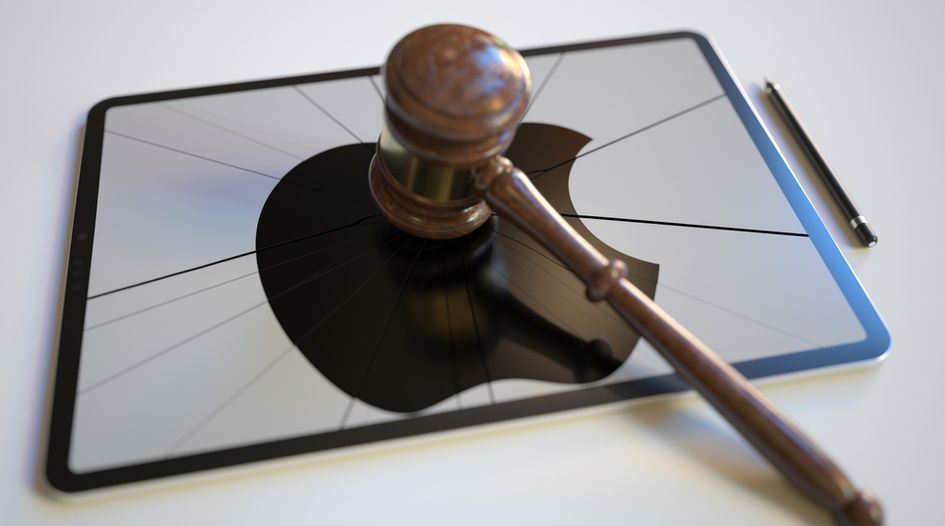Federal Circuit ruling against Apple demonstrates limits of trademark tacking

In Bertini v Apple Inc (21-2301; Fed Cir, 4 April 2023), the US Court of Appeals for the Federal Circuit reversed the TTAB’s decision to dismiss an opposition, addressing the requirements for a trademark owner to employ ‘tacking’ based on the use of a mark for one service in the context of a trademark application listing multiple services.
TTAB sides with Apple
Charles Bertini, US professional jazz musician and owner of the trademark APPLE JAZZ, filed a notice of opposition to Apple’s application to register the mark APPLE MUSIC. As the parties did not dispute that there was a likelihood of confusion between the two marks, the only disputed issue was which party’s mark was entitled to an earlier priority date.
Bertini’s mark had a priority date of 13 June 1985 for use in live music festivals and concerts. Apple’s mark, the subject of the opposition, had a priority date of 8 June 2015. In its application, Apple sought to register its mark for 15 broad service categories, including the production and distribution of sound recordings and the arranging, organising, conducting and presenting of live musical performances.
As Bertini’s mark had the earlier priority date, Apple attempted to use tacking to claim earlier priority through its 2007 purchase of the mark APPLE, registered by the Beatles’ Apple Corps in 1968 for gramophone records featuring music. Tacking allows a trademark owner to give a newly modified mark the priority date of its old mark, but only if, as stated by the US Supreme Court, both “create the same, continuing commercial impression so that consumers consider both as the same mark”. Upon review, the TTAB found that Apple was entitled to tack back to use the 1968 date of use for the APPLE MUSIC mark and thus had priority over Bertini. The board accordingly dismissed Bertini’s opposition – he then went onto appeal.
Federal Circuit reverses TTAB decision
In reviewing Bertini’s appeal, the Federal Circuit first addressed the tacking standard in the context of trademark registration. The court explained that to obtain an earlier priority date through tacking, an applicant must show that the old mark was associated with *all* of the goods or services listed in its application as of the proposed earlier priority date.
The Federal Circuit found that Apple failed to meet this burden. In its 1968 registration by Apple Corps, the APPLE mark was not associated with the service of “arranging, organising, conducting and presenting live musical performances”. As this service was listed in Apple’s trademark application, the APPLE MUSIC mark was not entitled to claim the priority date of the Apple Corp’s APPLE mark.
Conversely, the Federal Circuit noted that Bertini only needed to show the priority of use of APPLE JAZZ for any service listed in Apple’s application to succeed in his opposition. As the court rejected Apple’s attempt to tack back to the 1968 priority date for all of the APPLE MUSIC application’s listed services – the company could only show priority for one – Bertini met this burden. The court also concluded that the APPLE JAZZ mark had an earlier priority date than APPLE MUSIC for use in live musical performances.
The Federal Circuit explained that the TTAB erred in permitting Apple to tack back to 1968 as the priority date for all the services listed in its APPLE MUSIC application; its decision found that the services associated with the new mark were not “substantially identical” to those related to the old Apple Corp’s APPLE mark. Although the substantially identical requirement “does not require complete identity of the goods or services”, it does require that “the new goods or services [be] within the normal evolution of the previous line of goods and services”.
The court further recognised that although the evolution of music formats (eg, gramophone records, cassettes and CDs) would likely meet this substantially identical requirement, at least some of the services listed in Apple’s application went beyond the requirement’s applicable scope. It found that “live musical performances” were not substantially identical to gramophone records.
Ultimately, the Federal Circuit explained that the board erred by improperly focusing on Apple’s ability to tack use of APPLE MUSIC for only one of the listed services. Bertini only had to show his priority of use for APPLE JAZZ for any service listed in Apple’s application, and his use of APPLE JAZZ overlapped with two services listed in the company’s application.
This is an Insight article, written by a selected partner as part of WTR's co-published content. Read more on Insight
Copyright © Law Business ResearchCompany Number: 03281866 VAT: GB 160 7529 10

